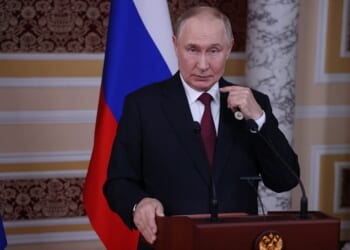Is Donald Trump a Trumpist? Or is he really an unacknowledged heir from Queens of the Bush dynasty? Is the 45th and 47th president of the United States a Russian matryoshka doll, whose well-coiffed head can be lifted off to reveal a figurine of Bush 43, which in turn contains Bush 41?
Americans on the Right have reasons to wonder. Recently a number of self-styled spokespersons for MAGA have claimed that the president has betrayed his populist base on issues ranging from foreign policy (with his bombing of Iran and threats of war against Venezuela), to higher education (with his insistence on admitting Chinese students to US universities to maintain university enrollments and budgets). At the same time, old-fashioned conservatives complain that Trump has betrayed the legacy of Ronald Reagan and the two Bushes with his stances on trade and immigration.
Both sides are half-right — and thus half-wrong. Just as he demolished the East Wing of the White House to add a new ballroom, while leaving the rest of the structure intact, so Trump, instead of completely replacing the older version of conservatism, has added a new populist wing based on trade and labor protectionism.
Pre-Trump “fusionist conservatism,” forged by the likes of William F. Buckley and Frank Meyer in the last century, is often compared to a stool with three legs: a hawkish foreign policy, free-market libertarianism in economics, and social conservatism. Trump himself never fit that model. During his 2016 campaign, he described the Iraq War as a “disaster” and vowed not to cut Social Security or Medicare. And while George W. Bush is a born-again Christian, Trump is a thrice-married playboy who told evangelicals at Liberty University that his favorite book in the Bible is “Two Corinthians.”
In contrast to their leader, the priorities of most congressional Republicans in Trump’s second term, as in his first, have been Bush-like: to expand the deficit with tax cuts for the rich, or to attempt to cut or destroy ObamaCare without offering any replacement other than a few half-baked ideas. Little seems to have changed with the GOP caucus since the days when Paul Ryan was House speaker (Ryan himself, feeling betrayed as a “true” conservative refused to vote for Trump in 2024 and said: “I’m going to write in a Republican”).
Yet the betrayal charges — from MAGA populists and doctrinaire Reaganites alike — misunderstand something fundamental about Trump.
Far from breaking completely with Republican anti-statism, he began his second term by assigning Elon Musk, a libertarian tycoon, and Russell Vought, a veteran of pre-Trump conservatism, with the task of firing as many civil servants as possible and wrecking as many agencies as they could, often in blatant violation of statutory law and the Constitution.
In foreign policy, it’s true that Trump in his first term was cautious compared to his predecessors. He didn’t start any new wars, unlike George W. Bush, who launched an unnecessary “forever war” in Iraq alongside the one in Afghanistan; and Barack Obama, who presided over a needless war of choice against the Qaddafi regime in Libya and who fueled an insurgency in Syria that empowered an Al Qaeda warlord, now donning ill-fitting suits.
In the first year of his second term, however, Trump has called for the annexation of Greenland and renamed the Gulf of Mexico to the “Gulf of America.” He has bombed Iran, something the two Bushes refused to do. In recent days, he has threatened to invade Nigeria in response to the Islamist persecution of Nigerian Christians, and appears to be making preparations for war with the Maduro dictatorship in Caracas.
Venezuela happens to be No. 1 among the countries in proven crude oil reserves, surpassing Saudi Arabia, and No. 8 in gas reserves. Iran is No. 4 in crude oil reserves and No. 2 in gas reserves. Nigeria is No. 10 in oil reserves and No. 9 in gas reserves. Wars or threats of wars of regime change against an axis of oil-rich countries bring to mind those two Texan oil men, George W. Bush and the late Dick Cheney, and appealing to evangelical voters (as the Nigeria initiative does) in the service of Petropolitik is very Bushian.
“American political parties are Frankenstein’s monsters.”
Trump, then, hasn’t broken with the legacy Reagan-Bush consensus on all issues. But on two issues — trade protectionism and labor market protectionism through immigration enforcement and restriction — he has departed radically from the older conservative agenda. Trump has won the presidency twice because he has added to the inherited GOP base a bloc of non-college-educated working-class voters — mostly, but not exclusively, white — who were alienated by the support for free trade and mass immigration of the Bush Republicans in the 1990s and aughts. In other words: He has united Reagan-Bush voters with the kind of voters who in the 1990s voted for H. Ross Perot.
Despite his successes in foreign policy, including the prosecution of the Gulf War and negotiations to end the Cold War, George H. W. Bush, who promoted economic austerity and free trade, repelled many white working-class voters who had been “Nixon Democrats” and later “Reagan Democrats.”
Many of these voters were drawn to the folksy Texan billionaire Ross Perot and his personal presidential vehicle, the Reform Party. Perot garnered 19% of ballots in the 1992 election, more than any third-party candidate since Theodore Roosevelt ran as the nominee of the Progressive Party against his Republican successor, William Howard Taft, and the Democrat Woodrow Wilson in 1912. Perot’s strongest supporters included many high-school-educated white men and women and union members in the industrial states — the kind who later put Trump in the White House twice.
Of Perot’s two main issues, economic nationalism and the budget deficit, the former was critical to his working-class support. NAFTA was negotiated under George H. W. Bush and later pushed through Congress by President Bill Clinton in 1993 with only Republican votes. In the House, most Democrats voted against NAFTA, 156 to 102, while Republican support was overwhelming, 132 to 43. GOP senators voted for NAFTA 34 to 10, while Democrats opposed the treaty by 28 to 27.
Perot was ridiculed when he claimed that the passage of NAFTA would result in a “giant sucking sound” of factories and jobs offshored to Mexico. But he was right. Thanks to offshoring by US companies and investment by European and Asian auto makers exploiting low Mexican wages and access to the American market, Mexico today is the third-largest automotive exporter in the world, above the United States and Japan and below only China and the European Union, while Detroit, the former “Motor City,” is a desolate wasteland.
With the transfer of production to Mexico and the anti-union American South, the wages of formerly well-paid auto workers, adjusted for inflation, declined by more than 17% from 1990 to December 2018, falling below the private-sector average in general.
In his two terms, George W. Bush compounded the damage done by NAFTA to America’s working class by complacently presiding over the offshoring of much of American manufacturing to Communist China as well as to Mexico and other low-wage nations. Meanwhile, his administration, on behalf of cheap-labor employers, turned a blind eye to massive illegal immigration from Mexico and elsewhere. “Protectionist” became an epithet in the Bush-era GOP.
In 1999, after Perot indicated he wouldn’t run a third time, Trump ran for the presidential nomination of Perot’s Reform Party but dropped out. The nomination went instead to the paleoconservative firebrand Patrick Buchanan, whom Trump denounced as an “anti-Semite” and “Hitler lover.” In 2015, Trump chose to run for the presidential nomination of one of the two major parties, instead of a third party, and unlike Perot, he became president — twice.
While most of the pre-Trump Republican coalition of hawks, social conservatives, and free-market libertarians remains, Trump has won back many of the working-class voters of the kind who were drawn to Nixon and Reagan but driven away by the two Bushes. Trump doesn’t owe his success to the “culture war,” which was a specialty of the Bushes, as they tried to divert attention from their country-club economic agenda by waving the flag and thumping the Bible. Trump won because, like Perot, he made protection central to his agenda — the protection of American industries from foreign competition, and the protection of American workers from immigrant competition.
In his first term, he rewarded these voters with the US-Mexico-Canada Agreement, which replaced NAFTA, and in his second term, he has cracked down against illegal immigration, including not only criminal migrants, but also unauthorized workers used as pawns by scofflaw employers to lower wages and evade workplace laws.
But in domestic policy, Republicans remain mostly hostile to organized labor and regulation of any kind, and Trump has gone along with the old anti-government Right in backing Vought and Musk and DOGE. The result under Trump is a hybrid — a synthesis of economic nationalism in trade and immigration policy with old-fashioned anti-government conservatism inside America’s borders.
Is tariff-fenced free-market conservatism in one country a stable policy? It worked for the Republicans for more than half a century between the Civil War and the Great Depression, when most of the GOP combined support for protective tariffs with opposition to organized labor and costly government. In his second Inaugural Address, Trump declared that President William McKinley, known in his time as “the Napoleon of Protection,” “made our country very rich through tariffs.”
He also echoed President Calvin Coolidge, who on Labor Day in 1924, told a group of union leaders that high wages for American workers depended upon immigration restriction and protectionism in trade policy. A “tremendous influx” of immigrants would be followed by “an almost certain reduction of wages.” He continued: “Under free trade, the only way we could meet European competition would be by approaching the European standard of wages. I want to see the American standard of living maintained. We shall not be misled by any appeal for cheap goods, if we remember that this was completely answered by President McKinley when he stated that cheap goods make cheap men. By restrictive immigration, by adequate protection, I want to prevent America from producing cheap men.”
Such hybridity is a feature of American party politics. Party realignments in the United States never involve the complete replacement of an old party with a new party that differs on every issue. American political parties are Frankenstein’s monsters that are altered with the amputation of some limbs and the addition of pieces of dismembered parties.
Abraham Lincoln’s Republican Party stitched former Jacksonian Democrats opposed to secession and slavery, and single-issue abolitionists to the remnants of the moribund Whig Party. Franklin D. Roosevelt sewed formerly Republican progressives, black voters, and white-ethnic urban immigrant groups that had been divided among the parties onto the Southern core of the older Democrats.
In 1968, the American Party candidacy of George Wallace, the segregationist Democratic governor of Georgia, split the Democratic coalition, allowing Richard Nixon to defeat Lyndon Johnson’s vice president, Hubert Humphrey, the Democratic nominee. Four years later, Nixon managed to weld many former Wallace populist voters to the Republican Party, creating a presidential majority coalition that Reagan inherited.
Like Lincoln, FDR, and Reagan, Trump has brought about a genuine realignment, recruiting formerly disaffected voters by adding a fourth leg to the conservative tripod, providing two economic legs, as it were — protectionism and immigration restriction in external economic affairs and free-market libertarianism at home. But his voters, again like Perot’s, are swing voters, not part of the Republican base.
As Trump himself has pointed out, other Republican office-seekers do best in election years when he is on the ticket. And like their predecessors, they can be driven away from the GOP by too much militarism on the part of the hawks, too much anti-government fervor on part of the free-marketeers, and the kind of religious rhetoric that appeals to the dwindling number of evangelicals in America but repels most other voters.
For all his flaws, Trump saved the GOP from dwindling into a permanent minority party of bellicose hawks, evangelicals, and libertarian opponents of the New Deal. Whether the Trump coalition survives Trump’s departure from office may depend on whether the GOP swaps out the old three-legged stool for Trump’s four-legged stool.

















